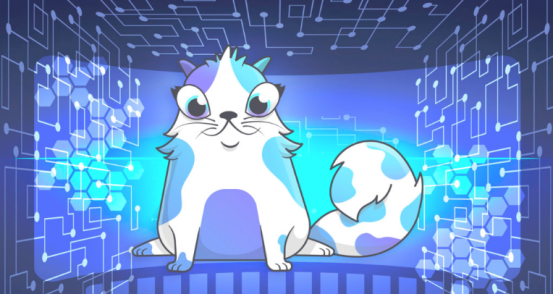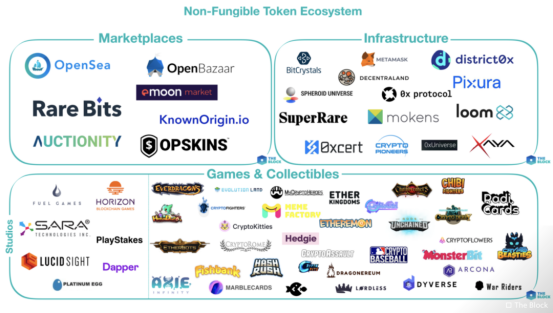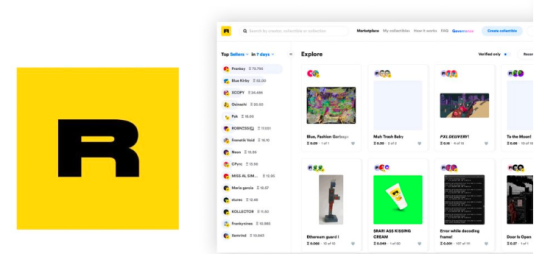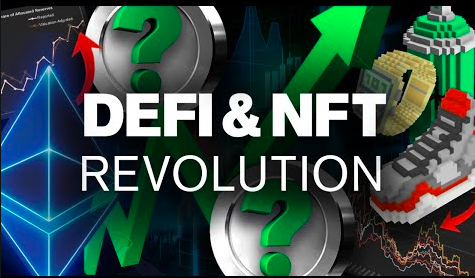NFT gradually gains momentum, understand the second world beyond Ethereum DeFi
Thanks to the emergence of new smart contract platforms (such as decentralized finance), Ethereum has always been the star project of the crypto economy in 2020. In addition to DeFi, non-homogeneous tokens (NFTs) have taken a new path to bring new life to Ethereum. As long as NFT is mentioned, the non-cryptocat and other Ethereum NFT games that have been in my mind are none other than. Although the concept of NFT is relatively new, it is worth noting that most of the activities of NFT so far have been carried out on the Ethereum public chain.
If DeFi is composed of "currency Lego", then NFT can be understood similarly as a programmable "media Lego". To put it simply, these special tokens are provably scarce digital assets, the provenance and ownership of which are permanently guaranteed by the Ethereum blockchain.
Whether it's artists, developers, etc., these new encrypted native token standards empower creators in ways that were impossible before, such as directly incorporating automatic royalties into digital assets.
So, in today's article, let us analyze NFTs: what they are, how they are produced and sold, how to collect them, and so on.

What are NFTs?
The full name of NFT is Non-FungibleToken (non-fungible token), what we generally see is a homogenized token. For example, 1 BTC in your hand and 1 BTC in other people's hands are the same, the anchor value is equal, and they can be exchanged at will.
Fiat currency is a homogenized currency. For example, a five-dollar bill is completely interchangeable with any other five-dollar bill. Similarly, cryptocurrencies such as Bitcoin and Ethereum are also interchangeable, that is, 1 BTC can be swapped with 1 BTC, 1 ETH can be swapped with 1 ETH, and so on.
Conversely, NFTs rely on special token standards such as ERC-721 to ensure uniqueness. Driven by blockchain technology, NFTs are not interchangeable, and have verifiable uniqueness and scarcity.
Non-homogeneous token (NFT) is a unique Token in the vernacular. Even in the same system, NFT exists alone. And unlike BTC and ETH, which can be divided into 0.1 or 0.0002, the unit of NFT is always 1! NFT features: unique and inseparable.

From this perspective, NFTs are like digital collectibles or proof of ownership. They are valuable because they are 1:1 or limited edition assets, which are liquid and practical on the Ethereum platform.
In 2017, with the launch of collectible items such as CryptoPunks and CryptoKitties, the NFT ecosystem began to enter the public eye. Since then, the field has blossomed towards various new use cases and industries. According to the analysis website NonFungible.com, so far, the token sales of the NFT economy have exceeded 109 million U.S. dollars, of which only one million U.S. dollars in revenue last week!

NFT ecology (picture source: The Block)
Different types of NFTs
NFT can tokenize almost anything, especially various media types are achievable goals. So far, the most common use cases for NFT are:
· Digital art (SuperRare, KnownOrigin, Async Art, Rarible, etc.);
· Digital music (Mintbase, InfiNFT, etc.);
· Virtual real estate (Cryptovoxels, Decentraland, etc.);
· VR wearable devices;
· Game assets (Axie Infinity, Sorare, Gods Unchained, etc.);
· Event tickets/admission tickets;
· Subscription badge;
· Blockchain domain names (Ethereum Name Service, Unstoppable Domains, etc.);
· Tokenized luxury goods, such as wine;
· Tokenized insurance policy (yEarn's yInsure token, etc.)

Rarible: the hot Ethereum NFT market
Create NFT: start from file
If you are interested in creating NFTs, you must first clarify the medium. NFTs can support a series of files, such as visual files (JPG, PNG, GIF, etc.), music files (MP3, etc.), 3D files (GLB, etc.), etc.
In other words, start creating NFTs like other media files, whether it is JPG photos uploaded to your computer or disco MP3 tracks created using music production software. Once the traditional file is ready, you only need to take an extra step to upload it to the minting platform in order to mark it as NFT.
How to cast NFTs
There are a series of NFT minting platforms in the Ethereum ecosystem, and they all have their own trade-offs.
First, there are DIY minting platforms like OpenSea, Rarible, InfiNFT, Mintbase, and Cargo. Regardless of whether these assets are exquisite digital art, membership cards, etc., these projects allow creators to cast their own NFT easily and without permission.
In addition, especially in the field of digital art, there are some exclusive membership-based NFT coin minting platforms. Creators must first apply and pass these platforms before they can mint coins. For example, SuperRare and Async Art are such projects.
Once you have prepared the files and the chosen coin platform, you will connect to the chosen Ethereum wallet, upload the file (similar to the way on mainstream platforms such as Imgur or Flickr) to the platform, and fill in the subsequent description of the asset.
In this process, you can set whether you want to create an independent or version-based work, the proportion of asset royalties, unlockable content, and so on. Once all these are ready, the minting process can begin, but a certain amount of ETH payment approval and minting transactions are required in advance.
Note: Ethereum Gas fees have remained high in recent weeks, and many NFT creators are facing extremely high minting costs. In order to cope with this situation, creators can 1) wait for the gas fee to decrease, 2) wait for the layer2 expansion solution to be widely accepted, 3) or increase the NFT price to compensate for the gas fee.
About selling NFTs
Open market platforms like OpenSea and Rarible can easily sell NFTs in the entire ecosystem, especially the former platform is particularly useful for auctions.
To sell NFT, you can connect your Ethereum wallet to the platform of your choice. If you have already created an NFT, click and see a "sell" prompt, and finally click and sign the transaction to complete. If you have collected someone else’s NFT and want to sell it, the process is similar: click on the asset, and then follow the “sell” instructions, you can get income.
Questions about evaluating and collecting NFTs
How much should an NFT pay, or how much should an NFT be sold for? There is no right or wrong answer, but there are some key concepts to remember.
If you are just a curious experiment, then pricing is obviously not that important. If you are keen on the return on investment of NFT activities, then you will want to be more detailed about the price of buying or selling. If this is the case, you have to keep in mind: prestige, scarcity and provenance are the most important. For example, a 1:1 NFT by a famous artist is more valuable than a version by a lesser-known creator.
NFT projects have floor prices. You can use platforms such as OpenSea to measure the lowest prices of these products, hoping to bid at this punctuation or above. Pay close attention to trading volume and trading activity. The higher the activity, the more profit opportunities provided by the project.
Remember that the motto "not your keys, not your crypto" also applies to NFTs. This is why it is really important to pay attention to security issues in the process of collecting them. The best practice is to store NFTs in a hardware wallet (or across multiple wallets), which is not easy to attack.

in conclusion
Now is the period when the NFT economy is booming and the NFT market is ushering in tremendous development. We may even see explosive cost growth in the industry. Combining the fact that recent projects have tried NFT+DeFi, it is easy to see that NFT will continue to increase its practicality and popularity from here.
Of course, compared with DeFi, the scale of the NFT field is still relatively small, but it has already empowered today's creators through unprecedented methods. Supporters of NFT can't hide their ambitions and expectations: NFT will reshape the game field; NFT will transform the traditional collectibles market; NFT can even have an impact on the traditional real estate industry. Of course, some critics will pour cold water on this: NFT is still only a small hobby in a small circle. It lacks uniform standards and does not have large funds. It will take a long time for NFT to mature.
Over time, more and more artists and innovators use these tokens to realize their unique attributes, and then expand in new ways. In addition, with the popularity of Ethereum, platforms other than Ethereum will further shift their focus to NFTs.